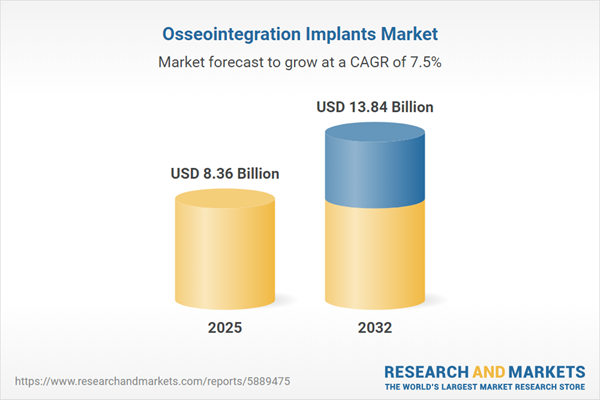Speak directly to the analyst to clarify any post sales queries you may have.
Senior executives in the healthcare sector need actionable, timely intelligence to navigate the evolving landscape of the osseointegration implants market. In a climate shaped by regulatory shifts, diverse clinical requirements, and ongoing advancements, strategic insights enable faster adaptation and stronger performance across interdisciplinary care delivery.
Market Snapshot: Osseointegration Implants Market Overview
The global osseointegration implants market is demonstrating steady growth, with projections indicating an increase from USD 7.76 billion in 2024 to USD 8.36 billion in 2025, and a forecasted value of USD 13.84 billion by 2032—representing a 7.48% CAGR.
This resilient momentum reflects accelerated innovation in implant design, biomaterials, and micro- and nano-engineered surfaces that elevate clinical results across dental, orthopedic, and craniofacial applications. Regulatory adaptation is supporting swifter clinical adoption, while digital health technologies streamline operations and drive more tailored patient care. As stakeholders face a rapidly shifting environment, market intelligence on these drivers has become indispensable for informed leadership.Scope & Segmentation: Strategic Insights for Senior Decision-Makers
- Material: Titanium and zirconia implants deliver mechanical stability and enhanced biocompatibility, meeting a range of patient and procedural needs across care settings.
- Application: Treatment options encompass dental interventions, orthopedic restorations, and craniofacial reconstructive procedures, supporting collaborative medical practice and broader adoption.
- Product Type: Both plate form and root form solutions are offered, giving clinicians vital flexibility to match anatomical and surgical requirements.
- End User: Key decision-makers include hospitals, ambulatory care centers, and specialized dental clinics, who are instrumental in driving procedural volume, resource allocation, and care model integration.
- Geographic Coverage: The analysis spans the Americas (US, Canada, Mexico, select South America), EMEA (UK, Germany, South Africa), and Asia-Pacific (China, India, Japan, Australia, South Korea), providing a foundation for local and regional strategy optimization.
- Key Companies: Executive profiles facilitate direct benchmarking of leaders such as Institut Straumann AG, Nobel Biocare Holding AG, Envista Holdings Corporation, Zimmer Biomet Holdings, Osstem Implant Co., BioHorizons IPH, MegaGen Implant Co., Dentium Co., DIO Implant Co., and Bicon LLC, supporting executive-level partnership and portfolio decisions.
- Technological Innovations: Advancements include micro- and nano-textured implant surfaces, new alloy formulations, additive manufacturing, and computer-aided planning with integrated digital monitoring—all contributing to efficiency and patient-centric care.
Key Takeaways: Osseointegration Implants Market
- Reliability in bone integration and rehabilitation fosters support for multidisciplinary clinical teams, increasing procedural confidence and improving recovery pathways.
- Emerging biomaterials and advanced surface features minimize complexity, resulting in shorter procedures and smoother post-care workflows.
- Digital solutions are helping providers transition to patient-oriented models, delivering greater adaptability and actionable data for resource allocation.
- Strategic adaptation to regulatory frameworks is essential for integrating technological innovations while preserving compliance and organizational agility.
- Robust supply chain planning and adaptable procurement strategies are vital for mitigating the impact of regulatory variation and maintaining operational stability.
- Deployment of analytics and digital health platforms drives measurable improvements in care standardization and system efficiency across diverse healthcare networks.
Tariff Impact: Navigating U.S. Policy Shifts
Adjustments in U.S. tariff regulations are prompting supply chain leaders to reassess sourcing and distribution strategies within the osseointegration implants market. Strengthening domestic supplier relationships, leveraging flexible procurement agreements, and diversifying supply channels are essential risk mitigation measures for cost and continuity management amid evolving trade scenarios.
Methodology & Data Sources
This report synthesizes comprehensive secondary research with expert insights from executive and clinical interviews. All findings undergo validation by sector specialists and are cross-referenced with authoritative regulatory, scientific, and industry data to produce dependable intelligence for upper management.
Why This Report Matters
- Equips senior decision-makers with current perspectives on advancing technologies, regulatory changes, and supply chain trends shaping the osseointegration implants sector.
- Empowers leadership teams to navigate sourcing challenges, manage operational risk, and set successful market entry strategies in complex clinical environments.
- Identifies high-value opportunities for partnership and operational enhancement, aligning organizations with trends in care delivery transformation.
Conclusion
Innovative implant technologies are redefining business and care delivery models across healthcare organizations. Equipped with precise intelligence, executive leaders will be positioned to advance operational performance and maintain strong patient care standards.
Additional Product Information:
- Purchase of this report includes 1 year online access with quarterly updates.
- This report can be updated on request. Please contact our Customer Experience team using the Ask a Question widget on our website.
Table of Contents
3. Executive Summary
4. Market Overview
7. Cumulative Impact of Artificial Intelligence 2025
Companies Mentioned
The companies profiled in this Osseointegration Implants market report include:- Institut Straumann AG
- Nobel Biocare Holding AG
- Envista Holdings Corporation
- Zimmer Biomet Holdings, Inc.
- Osstem Implant Co., Ltd.
- BioHorizons IPH, Inc.
- MegaGen Implant Co., Ltd.
- Dentium Co., Ltd.
- DIO Implant Co., Ltd.
- Bicon, LLC
Table Information
| Report Attribute | Details |
|---|---|
| No. of Pages | 182 |
| Published | October 2025 |
| Forecast Period | 2025 - 2032 |
| Estimated Market Value ( USD | $ 8.36 Billion |
| Forecasted Market Value ( USD | $ 13.84 Billion |
| Compound Annual Growth Rate | 7.4% |
| Regions Covered | Global |
| No. of Companies Mentioned | 11 |









